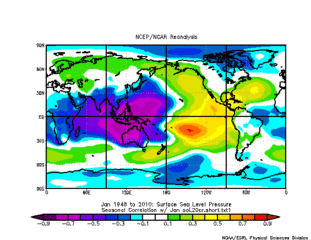20CR Climate Indices:SOI
- Description:
- This mode describes variability of the tropical atmosphere. It is often used as a measure of El Nino/La Nina and is correlated highly with ENSO indices. A high value represents higher surface pressure in the eastern tropical Pacific with more typical easterlies along the equator and is associated with La Nina's. A low value is associated with tropical surface westerlies and El Ninos.
- Image:
- Calculation Method:
- We used the definition in Ropelewski 1987 MWR. Surface pressure at the grid points nearest to Tahiti and Darwin represent the timeseries at those two locations. Each timeseries is first standardized using the 1981-2010 monthly climatology. The Tahiti minus Darwin timeseries is calculated. This timeseries is then re-normalized using 1981-2010 for the standardization.
- Time Interval: Monthly
- Time Coverage: 1851 to 2014
- Update Status: none
- Get Data:
- Update Status: none
-
SOI index: 20CRV2c Standard PSL Format (What is standard format?)
SOI index: 20CRV2 Standard PSL Format (What is standard format?)
SOI index 20CRV2c: Standard PSL Format (1948 onwards version)(What is standard format?)
SOI index 20CRV2: Standard PSL Format (1948 onwards version)(What is standard format?)
- Source:
- NOAA/ESRL PSL using method in reference below.
- References:
-
- Ropelewski, C.F. and Jones, P.D., 1987: An extension of the Tahiti-Darwin Southern Oscillation Index. Monthly Weather Review, 115, 2161-2165.
- NOAA/NCEP Climate Prediction Center (CPC) SOI monitoring data
- Other Links
 | Correlation of the 20CR-derived SOI timeseries and SLP from the NCEP/NCAR Reanalysis for 1948 to 2011. |